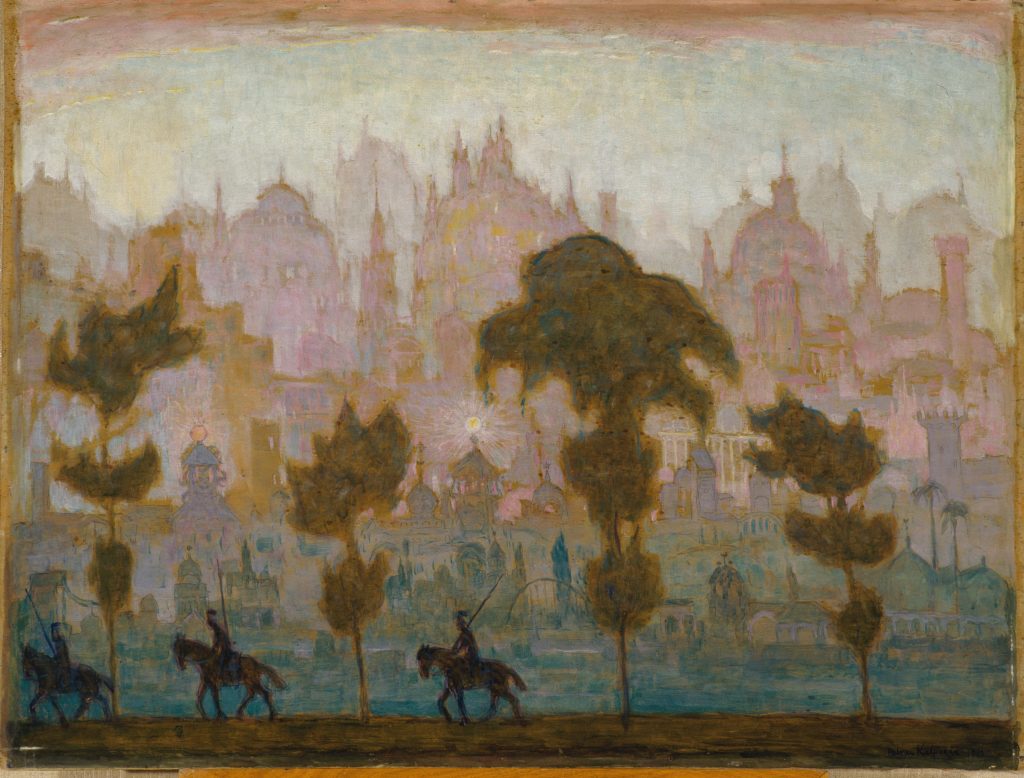2022 11 25 - 2023 01 28
visą dieną
Exhibition | Contemporaries: Petras Kalpokas and Mikalojus Konstantinas Čiurlionis
2022 11 25 – 2023 01 28
Petras Kalpokas, the contemporary of M. K. Čiurlionis, was only five years younger than him. Both artists began to study art almost at the same time, on the threshold of the 19th and 20th centuries: Kalpokas studied painting in Odessa (1898–1900), Jelgava, and Munich (1904– 1909), while Čiurlionis’ turn towards art began in Leipzig and Warsaw (1904–1906) after he had already received a musical education. Kalpokas was a member of the Munich Secession and took part in the genuine exhibitions of the “Kunstverein“ of German artists, while Čiurlionis exhibited his artworks in the exhibitions by the association of the same artistic tendency, “World of Art“, in St Petersburg. Both artists took part in the first Lithuanian Art Exhibitions in Vilnius (I–V, 1907–1911) while living in other countries than their native ones.
Both artists came of age at the turn of the Symbolism and Modernism eras. It was a time of the search for new spiritual values: the common interest in esoteric and occult trends, especially theosophy, psychology, philosophy of art, religions of Eastern civilizations, and myths, gave rise to a change in value systems and a search for new forms of artistic expression in Western culture. Symbolism spread and a rapid process of modernization of art towards abstractionism were going on as early as the first decade of the 20th century. The artworks by P. Kalpokas and M. K. Čiurlionis stood out because, in the general context of the development of European art, they were connected with the national movement and reflected the spirit of Lithuanian folk art.
Čiurlionis became interested in new ideas and thinking at the Warsaw School of Art, where he was influenced by the Symbolist oeuvre of Kazimierz Stabrowski, the leader of the Polish Theosophical movement but also by Arnold Böcklin’s paintings (especially his work “Island of the Dead”, of which as many as five versions are known). He also participated in the “wild strawberry tea party” rituals of the Wolman family, where discussions on philosophy and arts were led by Adam Mahrburg, a disciple and follower of Wilhelm Wundt. This is where the basic premise of Čiurlionis’ creative work originated: the true “art of ideas” should not imitate and reproduce nature, but should reflect the essence of universal ideas.
P. Kalpokas’ artistic views were strongly influenced by the environment and spiritual atmosphere of Monte Verita in Ascona, which began with a revolt against the industrial world and spilled over into a search for the mystery of the world, which was given impetus by the founder of modern theosophy, Helena Blavatsky. Utopians and reformers of various spheres lived and visited there, including Carl Gustav Jung, Hermann Hesse, Rainer Maria Rilke, Isadora Duncan, Paul Klee, Rudolf Steiner, Russian anarchists, and others. In the mornings there, the wife of the colony’s founder, the pianist Ida Hofman, would play Wagner, whose music influenced Kalpokas to create his most popular portrait, using which postcards are still reproduced, and the covers of audio CDs have been printed – for the first time, on the occasion of the composer’s anniversary.
Petras Kalpokas and Mikalojus Konstantinas Čiurlionis shared similar, new spiritual interests that were maturing and characterized the era, which was linked to a broader understanding of the development of culture and a deeper perception of the creative problems of that time.
At the beginning of the exhibition, in the first hall, we tried to juxtapose those artworks by P. Kalpokas and M. K. Čiurlionis which prove the closeness of the spiritual attitudes and artistic problems of both contemporaries, their symbolist aspirations, and compositional explorations, while the works in the second hall demonstrate the individuality of their personalities.
Nijolė Tumėnienė
Partners (private collections):
Lietuvos nacionalinis dailės muziejus
Nacionalinis M.K. Čiurlionio dailės muziejus
Lietuvos nacionalinis muziejus
OPENING HOURS:
Tuesday to Friday: from 11 a.m. to 5 p.m.
Saturday: from 1 p.m. to 5 p.m.
Monday and Sunday: CLOSED.

